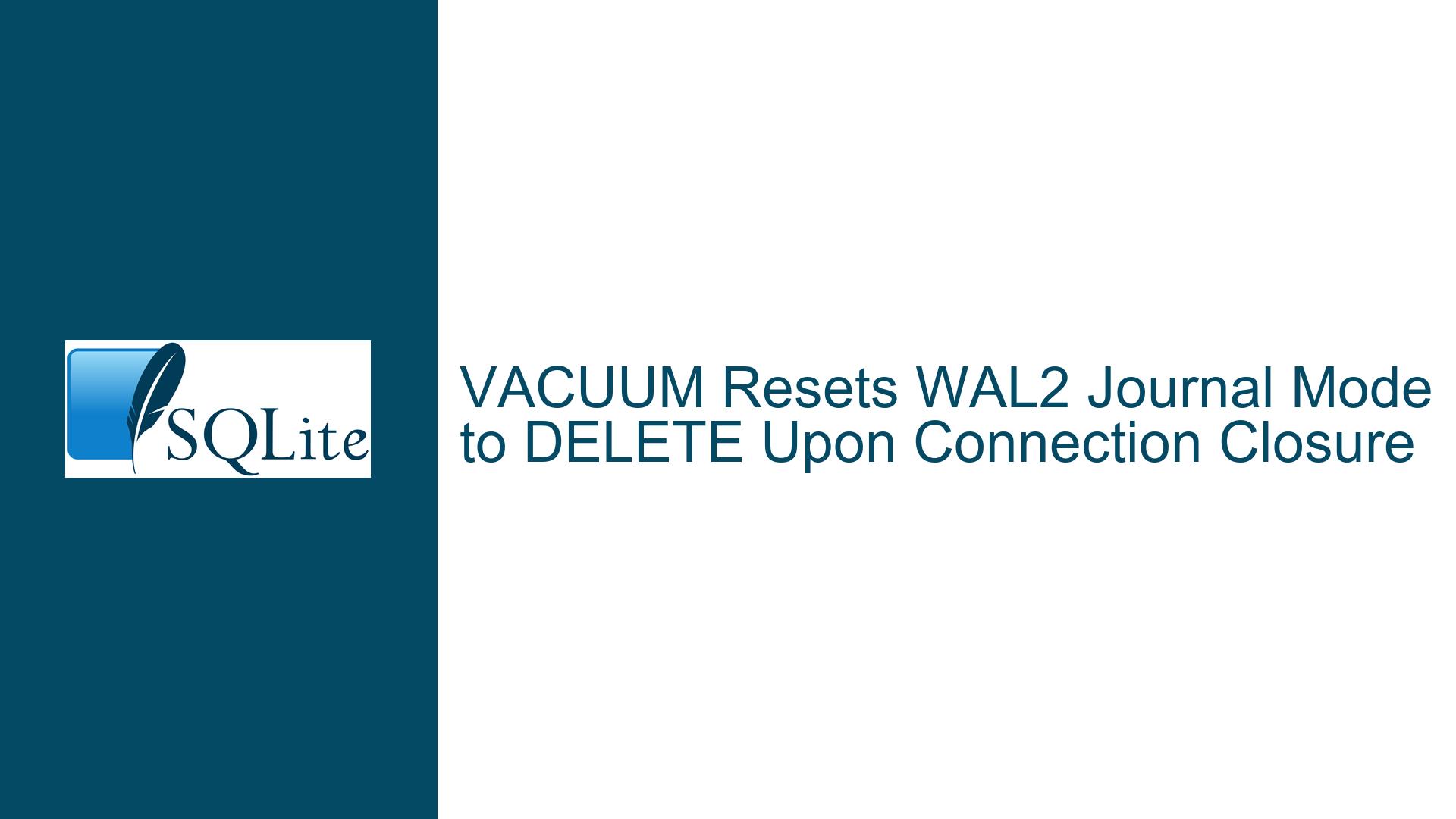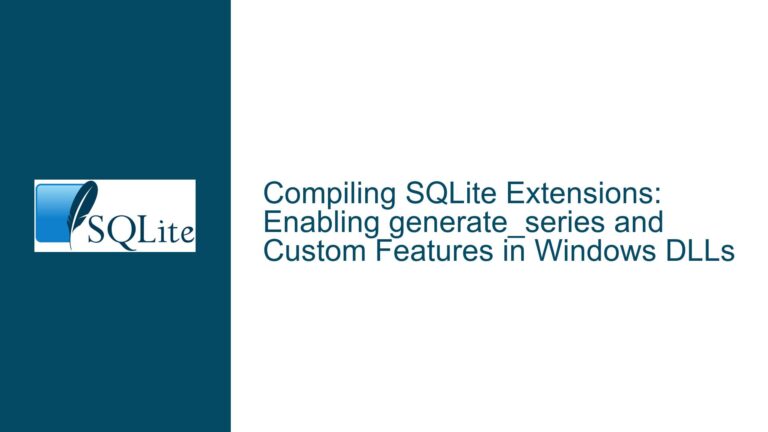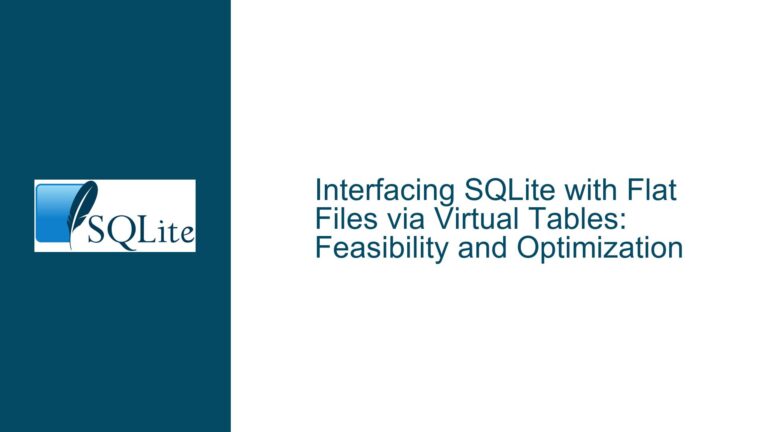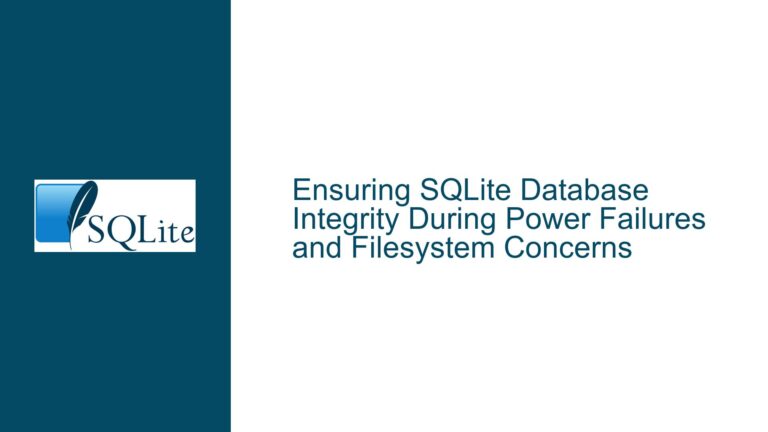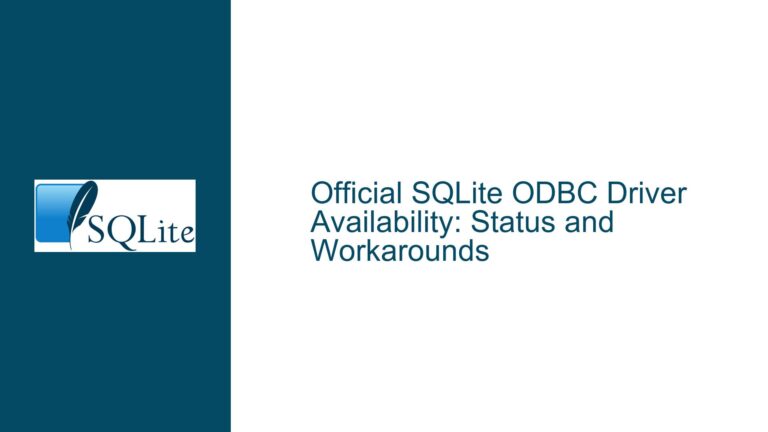VACUUM Resets WAL2 Journal Mode to DELETE Upon Connection Closure
Issue Overview: VACUUM Operation Disrupts WAL2 Journal Mode Persistence
The core issue involves the SQLite VACUUM command causing unintended reversion of the journal_mode from WAL2 to DELETE after all database connections close. This behavior is observed exclusively in databases configured to use the experimental WAL2 journaling mode (associated with the begin-concurrent-pnu-wal2 branch of SQLite). When a VACUUM is executed, subsequent connections to the database report WAL2 as the active journal mode while the initial connection remains open. However, once all connections terminate, the journal mode reverts to DELETE, even though the PRAGMA journal_mode; command initially reports WAL2 post-VACUUM. This discrepancy indicates a mismatch between the runtime journal mode configuration and the persistent state stored in the database file or its associated metadata.
The problem does not manifest with the standard WAL journal mode, which retains its configuration across VACUUM operations and connection cycles. The anomaly is critical because VACUUM is often used for database optimization, and inadvertent use in WAL2-configured databases can degrade performance or disrupt transaction guarantees by forcing a fallback to DELETE mode. This issue has been confirmed across multiple SQLite versions (3.35.3 to 3.40.0) in the experimental begin-concurrent-pnu-wal2 branch, suggesting a systemic problem in how WAL2 metadata is preserved during database reconstruction.
The WAL2 journaling mode is designed to enhance concurrency by maintaining two separate write-ahead logs (WAL files), allowing readers and writers to operate with reduced contention. Unlike DELETE mode, which uses rollback journals and locks the database during writes, WAL2 and WAL modes enable concurrent read and write operations. The VACUUM command rebuilds the entire database file, which inherently requires exclusive access and temporarily bypasses the WAL mechanism. However, the failure to restore WAL2 configuration after VACUUM completion implies that the database header or supporting structures are not updated correctly during the rebuild process.
Possible Causes: Metadata Inconsistencies and Branch-Specific Implementation Flaws
Database Header Reset During VACUUM:
TheVACUUMcommand operates by creating a temporary database, copying data from the original, then replacing the original with the temporary. During this process, the new database may inherit default settings unless explicitly reconfigured. TheWAL2mode, being experimental and branch-specific, might not have its metadata (e.g., thejournal_modeflag in the database header) preserved during the rebuild. StandardWALmode likely has explicit handling in the SQLite core to retain its configuration, whereasWAL2—due to its developmental status—may lack equivalent safeguards.Connection-Local Journal Mode Configuration:
SQLite’sPRAGMA journal_modeoperates at the connection level. When a connection setsjournal_mode=WAL2, the change applies only to that connection unless the database is in a state that allows persistent configuration (e.g., no active transactions, exclusive access). TheVACUUMcommand may temporarily revert toDELETEmode during execution (as it requires exclusive access), but a flaw in thebegin-concurrent-pnu-wal2branch could prevent reversion toWAL2post-VACUUM.WAL2 File Management and Cleanup:
TheWAL2mode relies on auxiliary files (-wal2and-shm2) to manage concurrent transactions. DuringVACUUM, these files are typically deleted or reinitialized. If theVACUUMprocess fails to recreate these files or update their metadata, subsequent connections may default toDELETEmode due to missing WAL2 infrastructure. This would align with the observed behavior where the journal mode resets only after all connections close—when SQLite performs final checks for WAL file validity.Branch-Specific Code Paths:
Thebegin-concurrent-pnu-wal2branch introduces modifications to supportWAL2and concurrent transactions. If theVACUUMimplementation in this branch does not account forWAL2-specific logic—such as updating the database header’s journal mode flag or regenerating WAL2 files—the post-VACUUMdatabase will lack critical markers needed to retainWAL2configuration.
Troubleshooting Steps, Solutions & Fixes: Diagnosing and Resolving WAL2 Persistence Failures
Verify Journal Mode Persistence Mechanisms:
- Inspect the Database Header: Use a hex editor or the
PRAGMA database_list;command to examine the database header’s journal mode flag. Compare the header values before and afterVACUUMto determine ifWAL2is being written correctly. - Check Auxiliary File Creation: After
VACUUM, confirm that the-wal2and-shm2files are regenerated. Their absence post-VACUUMindicates a failure in WAL2 initialization during database rebuild.
- Inspect the Database Header: Use a hex editor or the
Modify VACUUM Execution Workflow:
- Explicitly Reapply Journal Mode: Execute
PRAGMA journal_mode=WAL2;immediately afterVACUUMwithin the same connection. This forces the new database to adoptWAL2configuration, bypassing any automatic resets. - Disable Automatic Journal Mode Detection: Use
PRAGMA journal_mode=WAL2;in conjunction withPRAGMA locking_mode=EXCLUSIVE;beforeVACUUMto ensure the database remains in a state that favorsWAL2persistence.
- Explicitly Reapply Journal Mode: Execute
Branch-Specific Code Adjustments:
- Patch the VACUUM Command: In the
begin-concurrent-pnu-wal2branch, modify theVACUUMimplementation to explicitly set the journal mode toWAL2in the new database’s header. This may involve editing thesqlite3RunVacuumfunction to preserve non-standard journal modes. - Enhance WAL2 File Recreation Logic: Ensure that
VACUUMregenerates-wal2and-shm2files with appropriate metadata, mimicking the behavior of standardWALmode.
- Patch the VACUUM Command: In the
Workarounds for Production Environments:
- Avoid VACUUM in WAL2 Databases: Use
PRAGMA incremental_vacuum;or manualANALYZE/REINDEXoperations to optimize the database without full reconstruction. - Scripted Reconfiguration: Automate post-
VACUUMsteps to resetjournal_mode=WAL2and restart connections, ensuring configuration persistence.
- Avoid VACUUM in WAL2 Databases: Use
Long-Term Solutions:
- Mainstream WAL2 Integration: Advocate for merging
WAL2enhancements into the SQLite trunk, ensuring parity withWALin handlingVACUUMand other maintenance operations. - Enhanced Testing for Experimental Branches: Implement regression tests targeting
VACUUMbehavior under non-standard journal modes to catch similar issues during development.
- Mainstream WAL2 Integration: Advocate for merging
By systematically addressing metadata handling, branch-specific code paths, and operational workflows, users can mitigate the WAL2 journal mode reset issue and maintain desired concurrency configurations post-VACUUM.
